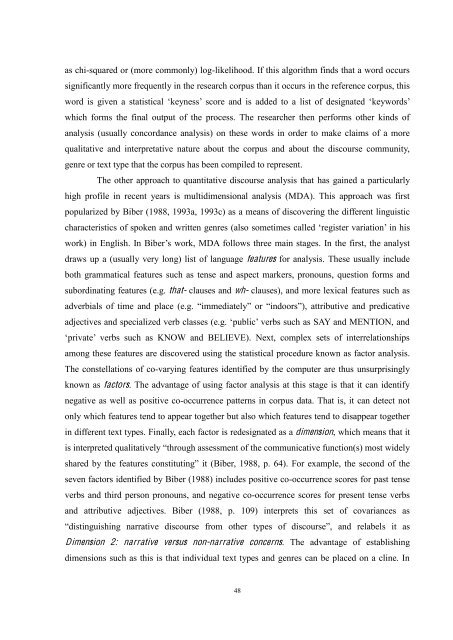Evaluative Meanings and Disciplinary Values - eTheses Repository ...
Evaluative Meanings and Disciplinary Values - eTheses Repository ...
Evaluative Meanings and Disciplinary Values - eTheses Repository ...
You also want an ePaper? Increase the reach of your titles
YUMPU automatically turns print PDFs into web optimized ePapers that Google loves.
as chi-squared or (more commonly) log-likelihood. If this algorithm finds that a word occurs<br />
significantly more frequently in the research corpus than it occurs in the reference corpus, this<br />
<br />
which forms the final output of the process. The researcher then performs other kinds of<br />
analysis (usually concordance analysis) on these words in order to make claims of a more<br />
qualitative <strong>and</strong> interpretative nature about the corpus <strong>and</strong> about the discourse community,<br />
genre or text type that the corpus has been compiled to represent.<br />
The other approach to quantitative discourse analysis that has gained a particularly<br />
high profile in recent years is multidimensional analysis (MDA). This approach was first<br />
popularized by Biber (1988, 1993a, 1993c) as a means of discovering the different linguistic<br />
characteristics of spoken <strong>and</strong> written genres (also sometimes called register variation in his<br />
work) in English. In Bibers work, MDA follows three main stages. In the first, the analyst<br />
draws up a (usually very long) list of language features for analysis. These usually include<br />
both grammatical features such as tense <strong>and</strong> aspect markers, pronouns, question forms <strong>and</strong><br />
subordinating features (e.g. that- clauses <strong>and</strong> wh- clauses), <strong>and</strong> more lexical features such as<br />
<br />
adj<br />
<br />
among these features are discovered using the statistical procedure known as factor analysis.<br />
The constellations of co-varying features identified by the computer are thus unsurprisingly<br />
known as factors. The advantage of using factor analysis at this stage is that it can identify<br />
negative as well as positive co-occurrence patterns in corpus data. That is, it can detect not<br />
only which features tend to appear together but also which features tend to disappear together<br />
in different text types. Finally, each factor is redesignated as a dimension, which means that it<br />
is interpreted qualitativel<br />
, 1988, p. 64). For example, the second of the<br />
seven factors identified by Biber (1988) includes positive co-occurrence scores for past tense<br />
verbs <strong>and</strong> third person pronouns, <strong>and</strong> negative co-occurrence scores for present tense verbs<br />
<strong>and</strong> attributive adjectives. Biber (1988, p. 109) interprets this set of covariances as<br />
s it as<br />
Dimension 2: narrative versus non-narrative concerns. The advantage of establishing<br />
dimensions such as this is that individual text types <strong>and</strong> genres can be placed on a cline. In<br />
48
















